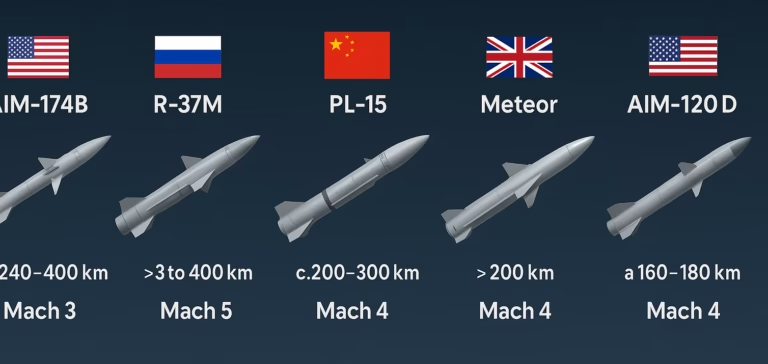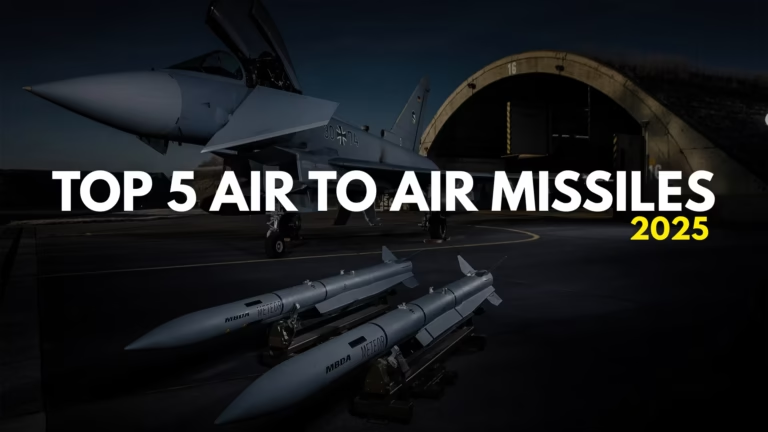Introduction
Long-range air-to-air missiles (AAMs) are key to modern air dominance. It’s clear that the country with the most advanced missiles will control the skies. In today’s era, air-to-air missiles are not just tools of defense — they represent strategic superiority.
Below we will talk about the top 5 air-to-air missiles, noting origin, users, performance, and unique features.
1. AIM-174B (USA)
The AIM-174B is a US Navy “longest-range” AAM derived from the ship-launched SM-6 missile. It is currently operated only by the US (on F/A-18E/F Super Hornets). Designed to engage high-value targets at extreme standoff, the AIM-174B revived Cold-War–style long-range combat capability.
Specifications:
Country of origin: United States (Raytheon)
Operators: United States Navy (F/A-18E/F)
Price per unit: ≈$4.3 million
Top speed: Mach 3.5 (≈4,287 km/h)
Maximum range: ~400 km (≈250 miles)
Engine: Solid-fuel rocket motor (derived from SM-6; dual-thrust)
Platforms: F/A-18E/F Super Hornet (others TBD)
Guidance: Inertial midcourse with two-way datalink and onboard active radar homing (SM-6 seeker)
Distinctive feature: Unmatched range for a fighter-launched AAM – roughly double that of AIM-120 AMRAAM It can also strike surface targets (inherited SM-6 multi-role capability)
The AIM-174B essentially converts the SM-6 into an air-launched weapon, thereby giving U.S. fighters an unprecedented reach. According to public sources, it has a top speed of roughly Mach 3.5 and a range of approximately 400 km. Furthermore, its large 64 kg warhead and networked guidance make it ideal for engaging high-value targets—such as AWACS, tankers, and incoming missiles—from outside adversary defenses. Although it is very heavy (around 1,600 kg), its true strategic impact lies in its ability to engage targets well beyond the range of current threats.
2. R-37M (Russia)
The R-37M (NATO “Axehead”) is Russia’s ultra-long-range AAM, developed from the R-33. It is carried by heavy Russian fighters (Su-35S, Su-57, Su-30, MiG-31BM, MiG-35). The R-37M’s key role is to engage large support aircraft (AWACS, tanker) from extreme stand-off.
Specifications:
Country of origin: Russia (Vympel)
Operators: Russian Aerospace Forces
Price per unit: Classified (not publicly disclosed)
Top speed: ~Mach 6 (≈7,400 km/h)
Maximum range: ≈300–400 km (cruise-glide profile)
Engine: Solid-fuel rocket (two-stage: booster + sustainer)
Platforms: Long-range interceptors and fighters (Su-57, Su-35S, Su-30SM, MiG-31BM, MiG-35)
Guidance: Inertial navigation + semi-active radar midcourse, transitioning to active radar terminal homing.
Distinctive feature: World’s fastest operational AAM (hypersonic) with the greatest no-escape zone. It is designed to cripple “support” aircraft from beyond their fighter escorts’ reach.
According to publicly available data, the R-37M can exceed Mach 5 and engage targets at distances ranging from 150 to 400 km, depending on the flight profile. Additionally, its 60 kg warhead and active radar seeker enable it to home in on targets independently. Moreover, the R-37M’s extreme speed—reaching approximately Mach 6—results in a very short engagement time, making it exceptionally difficult to evade. This rare combination of range and speed is nearly unmatched. However, the trade-off is that it must be carried by large, high-altitude aircraft, such as the MiG-31, capable of lofting such a heavy missile. Notably, it is specifically designed to intercept bombers and AWACS-type aircraft—targets that typically lack high maneuverability.
3. PL-15 (China)
The PL-15 (NATO “CH-AA-10 Abaddon”) is China’s new long-range AAM with an advanced AESA seeker. Developed by the China Airborne Missile Academy, it equips PLAAF and PLANAF fighters. The PL-15 entered service in 2017 and is also being exported to Pakistan.
Specifications:
Country of origin: China
Operators: People’s Liberation Army Air Force/Naval Air Force; recently exported to Pakistan
Price per unit: ~$200,000 (estimated export cost)
Top speed: > Mach 5 (hypersonic)
Maximum range: ~200–300 km (domestic); export variant PL-15E ~145 km
Platforms: J-20, J-10C, J-15, J-16, J-11B, JF-17B3 (among others)
Guidance: Inertial midcourse with two-way datalink; AESA active radar homing terminal
Distinctive feature: China’s longest-range fighter missile, optimized to counter AWACS and stealthy targets. The PL-15’s large dual-pulse motor provides sustained boost for very long range.
Open-source references report that the PL-15 has a range in the order of 200–300 km, thus placing it in the same class as Western rivals like the AIM-260/JATM. In addition, its Mach-5+ speed and modern seeker demonstrate China’s ongoing push to develop high-end air-to-air missile capabilities. Meanwhile, the PL-15’s export variant—the PL-15E—features a slightly reduced range of approximately 145 km.
A report suggests export pricing of roughly ¥1 million (≈$0.2M) for PL-15E, indicating China offers it cheaply to allies. The PL-15’s chief advantage is its range and advanced radar; it is seen as China’s match for long-range Western missiles
4. MBDA Meteor (UK/EU)
The Meteor is a European beyond-visual-range missile developed by MBDA, led by the UK, with significant contributions from Sweden, France, Italy, Germany, and Spain. Uniquely, it features ramjet propulsion, which enables a long “no-escape zone” by maintaining high speed throughout its flight. Furthermore, the Meteor is operational on several advanced platforms, including the Saab Gripen, Eurofighter Typhoon, Dassault Rafale, and the UK’s variant of the F-35.
Specifications:
Country of origin: United Kingdom (MBDA); multinational EU program.
Operators: UK (Typhoon, F-35B/C), France (Rafale), Sweden (Gripen), Italy/Spain/Germany (Typhoon) – over a dozen air forces.
Price per unit: Proprietary (government programs); estimated ~$3–4M (roughly similar to AIM-120D)
Top speed: > Mach 4 (sustained in flight).
Maximum range: >100 km (some sources say >200 km, depending on launch conditions).
Engine: Solid rocket booster + throttleable ducted ramjet.
Platforms: Eurofighter Typhoon, Saab JAS 39 Gripen, Dassault Rafale, F-35B/C (British/French).
Guidance: Inertial midcourse with two-way datalink updates; AESA active radar homing in terminal phase.
Distinctive feature: Largest no-escape zone of any AAM. Its ramjet sustains high speed late in flight, giving it end-game energy that outclasses conventional rockets.
According to MBDA, Meteor can engage targets beyond the horizon with pinpoint precision. Public specs list >100 km range and speed over Mach 4. Because of the ramjet, the Meteor’s “no-escape zone” (the region where a target cannot evade by maneuvering) is roughly three times larger than an AMRAAM of similar range.
This makes Meteor exceptionally lethal against agile fighters. As of 2025 it is widely regarded as the most advanced AAM in service, combining long reach with a sophisticated seeker and networking capability.
5. AIM-120D AMRAAM (USA)
The AIM-120D is the latest variant of America’s venerable AMRAAM family and continues to serve as the primary beyond-visual-range (BVR) missile for U.S. and allied fighters. Moreover, it is widely carried by the USAF, US Navy, and aircraft from over 30 partner nations. Notably, the D-model introduces enhanced kinematics and an upgraded datalink, improving both range and mid-course guidance.
Specifications:
Country of origin: United States (Raytheon).
Operators: USA and ~40 allied nations
Price per unit: ≈$1.09 million (FY2019 estimate for AIM-120D)
Top speed: Mach 4 (≈4,500 km/h)
Maximum range: ~160–180 km
Engine: Solid-fuel rocket motor
Platforms: Standard armament on US and allied fighters (F-15, F-16, F/A-18, F-22, F-35, Eurofighter, Gripen, etc.). Also used in NASAMS ground launchers.
Guidance: Inertial midcourse (with optional two-way datalink updates) and active radar terminal homing
Distinctive feature: Combat-proven, multi-role BVR missile with wide global use. Dubbed the “gold standard,” it balances performance, reliability and integration on many aircraft
According to official data, the AIM-120D has a range of about 160–180 km and a speed of Mach 4. Moreover, it carries a 20 kg blast-fragmentation warhead and uses a mature active-radar seeker. Additionally, Raytheon notes it has been integrated on fighters from over 40 countries. The AIM-120D’s strength lies in its blend of advanced guidance and broad deployment. Unlike rarer ramjet or hypersonic missiles, it serves as the backbone of many air arms. Furthermore, its cost (approximately $1 million each) is offset by mass production and decades of refinement.
Comparison and Most Advanced Missile

These are the top 5 air-to-air missiles, and each one pushes different performance trade-offs. Collectively, they are all beyond-visual-range (BVR) AAMs equipped with active-radar terminal homing and inertial midcourse guidance. Notably, the R-37M and AIM-174B stand out due to their extreme range (~300–400 km), which enables launches from well outside enemy defenses.
The R-37M is particularly unique for its hypersonic speed (~Mach 6), which gives it an enormous no-escape zone against slow-moving targets. Similarly, the AIM-174B extends the reach of U.S. fighters by roughly 30–50% compared to earlier missiles. Meanwhile, China’s PL-15 bridges the gap with an estimated range of ~200–300 km and speeds exceeding Mach 5, effectively matching Western performance at a relatively lower cost.
In contrast, the Meteor and AIM-120D rely on air-breathing and rocket propulsion, respectively. The Meteor’s throttleable ramjet, combined with a booster, sustains high speed throughout its flight, resulting in exceptionally strong endgame energy and a large no-escape zone. While official specifications cite a “100+ km” range, its real-world reach—especially against maneuvering targets—likely exceeds that of many pure-rocket missiles. On the other hand, the AIM-120D, which uses a solid rocket motor, is slower and has a shorter range than the Meteor. However, it remains the most widely fielded and technologically mature option in operational service.
Speed and range summary:
- R-37M (~Mach 6, ~~400 km)
- AIM-174B (~Mach 3.5, ~~400 km) lead in sheer reach.
- PL-15 (~Mach 5, ~200–300 km) is next.
- Meteor (ramjet) can fly over Mach 4 and 100+ km.
- AIM-120D is ~Mach 4 and ~160–180 km.
Guidance:
- All use active radar terminal seekers.
- R-37M/M also includes semi-active midcourse guidance.
- Meteor and AIM-120D add datalink updates in flight.
Most advanced/versatile:
Many analysts rank the Meteor as the most technologically advanced operational AAM, thanks to its throttleable ramjet and dominant no-escape zone. Its design is a game-changer against agile fighters.
However, each missile has its niche:
- The R-37M’s hypersonic speed and range make it the ultimate AWACS-killer.
- The AIM-174B currently gives the U.S. unparalleled reach.
- The PL-15 represents China’s cutting-edge BVR capability.
- The AIM-120D remains the battle-hardened, multirole standard.
In practice, “best” depends on mission: a country needing sheer reach may choose AIM-174B/R-37M, whereas agility and end-game energy favor the Meteor.






